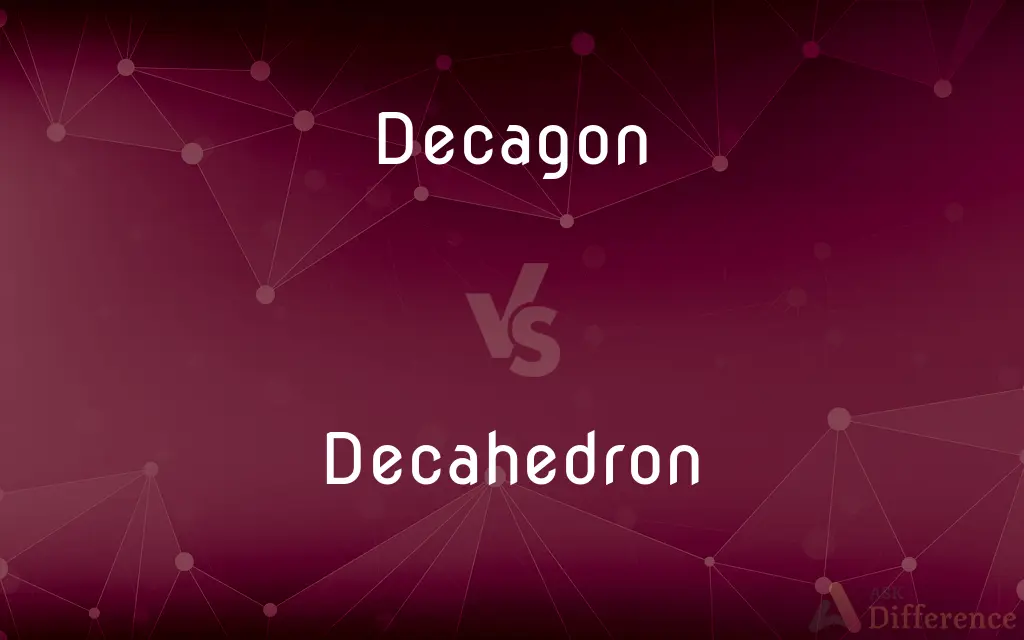Decagon vs. Decahedron — What's the Difference?
By Maham Liaqat & Fiza Rafique — Updated on March 28, 2024
A decagon is a two-dimensional shape with 10 sides and angles, commonly found in geometry, while a decahedron is a three-dimensional figure with 10 faces, appearing in geometry and 3D modeling.

Difference Between Decagon and Decahedron
Table of Contents
ADVERTISEMENT
Key Differences
A decagon is a polygon in two-dimensional geometry characterized by its ten sides and ten angles. It can be regular, with all sides and angles equal, or irregular, with variations in side lengths and angle measurements. Decagons are often studied in the context of geometry for their properties and the mathematical relationships between their angles and sides. On the other hand, a decahedron refers to any three-dimensional solid that has ten faces. Decahedra can vary greatly in shape and complexity, depending on the nature and arrangement of their faces, edges, and vertices. Like decagons, decahedra can be regular, with all faces being congruent polygons, or irregular, with varying face shapes and sizes.
The study of decagons primarily involves understanding the sum of interior angles, which is always 1,440 degrees, and exploring their symmetry and tiling possibilities. In contrast, the study of decahedra encompasses a broader range of geometric considerations, including volume, surface area, and the Euler characteristic, which relates the number of faces, vertices, and edges. Decagons are commonly found in architectural designs, art, and tiling patterns, serving both aesthetic and functional purposes. Decahedra, however, are more often encountered in three-dimensional modeling, crystallography, and as examples of various types of polyhedra in mathematical theory and applications.
While both decagons and decahedra are significant in the field of geometry, their applications diverge due to their dimensional differences. Decagons are simpler to construct and are often used to teach basic geometric principles and properties of polygons. Decahedra, with their three-dimensional complexity, are utilized in more advanced geometric studies, including topology and three-dimensional space exploration.
The distinction between decagons and decahedra highlights the fundamental difference between two-dimensional and three-dimensional geometry. Understanding these shapes provides a foundation for exploring more complex geometric figures and contributes to a broader comprehension of space and form in mathematics and applied sciences.
Comparison Chart
Dimensions
Two-dimensional (2D)
Three-dimensional (3D)
ADVERTISEMENT
Defining Feature
10 sides and angles
10 faces
Types
Regular (all sides/angles equal) or irregular
Regular (all faces congruent) or irregular
Study Focus
Interior angles, symmetry, tiling
Volume, surface area, Euler characteristic
Applications
Architecture, art, tiling patterns
3D modeling, crystallography, mathematical theory
Compare with Definitions
Decagon
Regular decagon has equal sides and angles.
A perfect ten-sided star is formed by extending the sides of a regular decagon.
Decahedron
Can be regular or irregular.
The crystal formed a natural irregular decahedron.
Decagon
Found in architectural designs.
The pavilion featured a decagon-shaped roof.
Decahedron
Used in 3D modeling.
The artist created a decahedron for the video game's artifact.
Decagon
Appears in mathematical problems.
Calculating the area of a regular decagon involves understanding its side length and apothem.
Decahedron
A solid with ten faces.
The puzzle toy was shaped like a regular decahedron.
Decagon
A polygon with ten sides.
The stop sign is an octagon, but adding two more sides would make it a decagon.
Decahedron
Discussed in mathematical theory.
The properties of a regular decahedron were explored in the geometry lecture.
Decagon
Used in tiling patterns.
The floor was adorned with a complex decagon-based tiling pattern.
Decahedron
Found in crystallography.
Some minerals crystallize in the form of a decahedron.
Decagon
In geometry, a decagon (from the Greek δέκα déka and γωνία gonía, "ten angles") is a ten-sided polygon or 10-gon. The total sum of the interior angles of a simple decagon is 1440°.
Decahedron
In geometry, a decahedron is a polyhedron with ten faces. There are 32300 topologically distinct decahedra, and none are regular, so this name does not identify a specific type of polyhedron except for the number of faces.
Decagon
A polygon with ten sides and ten angles.
Decahedron
A polyhedron with ten faces.
Decagon
(geometry) A polygon with ten sides and ten angles.
Decahedron
A polyhedron with ten faces.
Decagon
A plane figure having ten sides and ten angles; any figure having ten angles. A regular decagon is one that has all its sides and angles equal.
Decahedron
A solid figure or body inclosed by ten plane surfaces.
Decagon
A polygon with 10 sides and 10 angles
Decahedron
Any polyhedron having ten plane faces
Common Curiosities
Can a decahedron have all equal faces?
Yes, a regular decahedron has ten congruent faces, but an irregular decahedron does not.
Are all decahedra polyhedra?
Yes, all decahedra are polyhedra since a polyhedron is defined as a solid with flat faces, and a decahedron specifically has ten faces.
Can decahedra be found in nature?
Yes, decahedra can be found in crystal formations and certain molecular structures in nature.
Is it easier to construct a decagon or a decahedron?
Constructing a decagon is generally simpler because it is a 2D shape, whereas a decahedron requires understanding of 3D space.
Why are decagons significant in geometry?
Decagons help in understanding the properties and relationships of polygons, including angles, symmetry, and tiling.
What makes a decagon regular?
A decagon is regular if all its sides are of equal length and all its interior angles are equal.
Do decagons and decahedra share any properties?
While they are fundamentally different in dimensions, both can be regular, with congruent angles or faces, and play significant roles in geometry.
How do you calculate the volume of a decahedron?
The volume calculation depends on the type of decahedron; for regular decahedra, specific formulas based on the dimensions of the faces and the arrangement of the solid are used.
Can decahedra be used in technology?
Yes, decahedra are used in 3D modeling, simulations, and as geometric shapes in various technologies.
What is the difference between a decagon and a decahedron?
A decagon is a 2D shape with 10 sides, while a decahedron is a 3D solid with 10 faces.
What applications do decagons have?
Decagons are used in architectural design, art, and tiling patterns for their aesthetic and geometric properties.
What is the Euler characteristic of a decahedron?
The Euler characteristic (V - E + F = 2) relates the number of vertices (V), edges (E), and faces (F) of a decahedron, which helps in understanding its geometric structure.
Share Your Discovery

Previous Comparison
Brain vs. Grub
Next Comparison
Weasel vs. CatAuthor Spotlight
Written by
Maham LiaqatCo-written by
Fiza RafiqueFiza Rafique is a skilled content writer at AskDifference.com, where she meticulously refines and enhances written pieces. Drawing from her vast editorial expertise, Fiza ensures clarity, accuracy, and precision in every article. Passionate about language, she continually seeks to elevate the quality of content for readers worldwide.















































